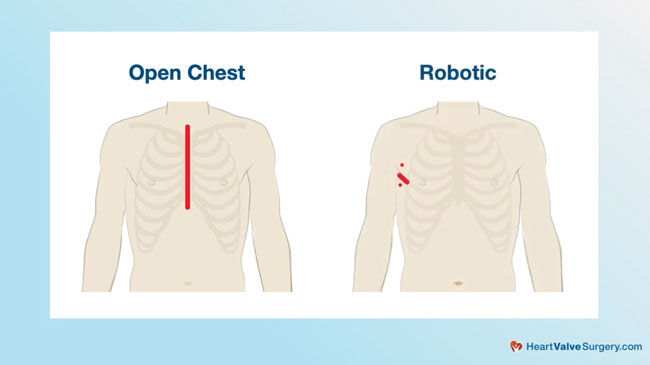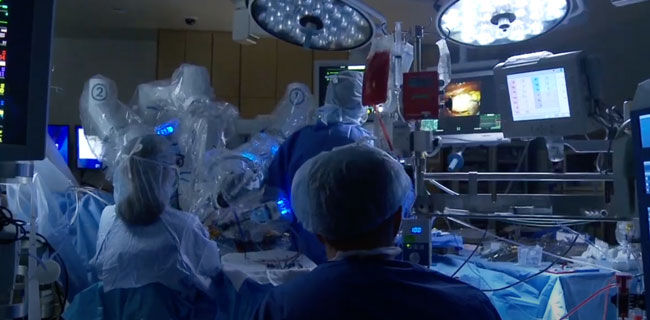Surgeon Q&A: My 15-Year Robotic Mitral Valve Surgery Experience with Dr. Thomas Molloy
Written By: Allison DeMajistre, BSN, RN, CCRN
Medical Expert: Thomas Molloy, MD, Medical Director of Cardiac Surgery, Northwest Regional Heart and Vascular at Adventist Health Portland
Reviewed By: Adam Pick, Patient Advocate, Author & Website Founder
Published: June 19, 2024
Now, more than ever, HeartValveSurgery.com is receiving questions about mitral valve repair and robotic surgery. So, we were thrilled when Dr. Thomas Molloy agreed to join us for a special “Question-and-Answer” session about his 15-year experience with robotic mitral valve surgery.
Dr. Molloy is the medical director of cardiac surgery at Northwest Regional Heart & Vascular at Adventist Health Portland. During his extraordinary career, Dr. Molloy has performed over 5,000 cardiac procedures with over 3,000 involving some form of heart valve repair or replacement.
Key Learnings About Dr. Molloy’s Experience with Robotic Mitral Valve Surgery
Here are important insights for patients from our interview with Dr. Molloy:
- Why did you choose to focus your practice on mitral valve repair? “I’ve always liked reconstructive surgery as opposed to excisional surgery,” Dr. Molloy said. “The mitral valve is the most repairable of valves in the heart, which is very important to the patient. Only 50% of mitral valves are repaired in the United States, and primary mitral insufficiency should be repaired at least 95% of the time. As a surgeon, if you understand how to repair the valve and study the various ways of repairing it, you can achieve those kinds of repair rates that will restore your patients to the age match peers’ quality and quantity of life: really no other surgery can claim to do that.”
- When and why did you begin using the robot for valve repair? “I started using minimally invasive thoracotomy techniques for mitral valve and aortic valve surgery in 2000. Patients don’t like a sternotomy,” Dr. Molloy said. “It takes a long time to recover from it, and exposure from the side is much better than through the center. The robot was a game changer when it came to precision, better visualization, and better exposure of the valve, so I switched to that in 2008.”

- Can the robot be used for all types of mitral valve surgery? “Yes, the robot can be used to repair or replace the valve,” Dr. Molloy told us. “The vast majority of our patients receive a valve repair, and all types of valve repair can be performed with the robot. In fact, we don’t do a different operation with the robot. We do the same operations that have been developed over the last 20 years. It allows us to do it with greater precision, less impact on the patient, and better cosmetic results for the patient.”
- Are there any misconceptions about using the robot for valve surgery? Molloy said, “Early on, many perceptions turned out to be incorrect. I would say one was that the procedure had a higher stroke rate. That may have been true early on, but surgeons learned over twenty years ago that they needed to do a CT scan before every one of these operations. The scan guided our perfusion techniques and eliminated the increased stroke risk seen in the early days of this kind of surgery. Another misconception is that the robot does the operation. The surgeon does the operation. The robot doesn’t know how to repair the valve. It’s really a fancy needle holder. There is also the misconception that the robot costs more. Studies have shown that it does cost more on the day of surgery, but because the length of stay is so much shorter, the cost is the same. Dr. Molloy said their average hospital stay with the robotic surgery is around three days. Mitral valve surgery with a sternotomy usually requires patients to stay in the hospital for an average of six to seven days. Dr. Molloy also said, “When you look at the return to work being so much earlier, there’s actually a saving there that’s not seen by the hospital but certainly appreciated by the patient.”

- Cardiac patients sometimes struggle with the use of pain medications after surgery, which can lead to addiction. Does the robot help avoid this problem? Molloy said, “That is a great point. Eight percent of patients who have a sternotomy for valve surgery or any other kind of open heart surgery develop narcotic addiction. Our patients are off narcotics almost 100% of the time within 24 hours. They never go home on narcotics. Narcotic addiction is zero in our patients.
- Are patients on the heart-lung machine longer during a robotic procedure? “Generally speaking, the bypass times are a bit longer on the heart-lung machine during a robotic procedure,” said Dr. Molloy. “It’s mostly in setting the patient up for the procedure and not the portion of the procedure where the heart is actually arrested. Studies have shown that the slightly longer bypass time does not affect outcomes with the patient.”
- Are there any nuances you’ve developed to help with patient experience and outcomes? “There are a number,” said Dr. Molloy. “Preoperatively, we’re very careful to avoid anemia. We treat anemia preoperatively and only transfuse patients 5% of the time, compared to 40% nationwide. In the operating room, we have a consistent team: the same tableside surgeon, the same console surgeon, and me in every case. We have a consistent team of perfusionists, anesthesiologists, scrub techs, and circulators. Postoperatively, our universal bed unit at Adventist Hospital is critical to our patients’ safe and rapid recovery. The patients don’t get moved around the hospital and have the same dedicated and sub-specialized nursing team from admission to discharge.”
- What is your number one piece of advice for patients considering robotic mitral valve surgery? “I think the most important thing is to choose a surgeon who performs a high volume of these procedures and posts their outcomes where you can see them, typically on their website,” said Dr. Molloy.
Thanks Dr. Molloy and Adventist Health Portland!
On behalf of our HeartValveSurgery.com patient community, thank you to Dr. Molloy for sharing his extensive experience and insights about minimally invasive robotic mitral valve surgery. A big thank you to his team at Adventist Health Portland, for continuing to take great care of heart valve patients everywhere!
Related links:
- See Dr. Molloy’s Interactive Surgeon Profile
- Video: Minimally Invasive Aortic Valve Surgery with Thomas A. Molloy, MD
- Dr. Molloy’s Patient Success Story: Tom Rhodes, Robotic Mitral Valve Repair
Keep on tickin!
Adam
P.S. For the deaf and hard-of-hearing members of our patient community, I have provided a transcript of this interview with Dr. Molloy below.
Video Transcript:
Adam Pick: Hi, everybody, it’s Adam with heartvalvesurgery.com. This is a special surgeon question and answer session all about robotic mitral valve surgery. I am thrilled to be joined by Dr. Thomas Molloy, who is the medical director of cardiac surgery at Northwest Regional Heart & Vascular at Adventist Health, Portland. During his extraordinary career, Dr. Molloy has performed over 5,000 cardiac procedures with over 3,000 involving some form of heart valve repair or heart valve replacement. Dr. Molloy, it is great to see you again and thanks so much for being with us today.
Dr. Molloy: Yes, glad to be here to talk about mitral valve surgery and my passion for minimally invasive valve surgery.
Adam Pick: We’re going to talk all about robotic mitral valve surgery, but first a question for you. Why did you choose to focus your practice on the repair of mitral valves?
Dr. Molloy: I’ve always liked reconstructive surgery as opposed to excisional surgery. The mitral valve is the most repairable of valves in the heart and repairing that valve is so important to the patient. Only 50% of mitral valves are repaired in the United States, and primary mitral insufficiency should be repaired at least 95% of the time. As a surgeon, if you understand how to repair the valve and study the various ways of repairing it, you can achieve those kinds of repair rates that will restore your patients to the age match peers quality and quantity of life; really no other surgery that can claim to do that.
Adam Pick: Dr. Molloy, I really appreciate you getting your patients back on the life expectancy curve, the normal life expectancy curve. I’m curious to know when and why did you start using the robot?
Dr. Molloy: I started using minimally invasive thoracotomy techniques for mitral valve and aortic valve surgery in 2000. Patients don’t like a sternotomy. It takes a long time to recover from it, and exposure from the side turns out to be much better than through the center. The robot was really a game changer when it came to precision and better visualization and better exposure of the valve, so I switched to that in 2008.
Adam Pick: Dr. Molloy, I’m sure patients are wondering, can the robot be used for all types of mitral valve surgery?
Dr. Molloy: Yes, Adam, the robot can be used to repair or replace the valve. The vast majority of our patients receive a valve repair and all types of valve repair can be performed with the robot. In fact, we don’t do a different operation with the robot. We do the same operations that have been developed over the last 20 years. It just allows us to do it with greater precision, with less impact on the patient and with a better cosmetic result for the patient.
Adam Pick: Dr. Molloy, are there any misconceptions about your use of the robot?
Dr. Molloy: Early on the perceptions that turned out to be incorrect were many. I would say one was that the procedure had a higher stroke rate. Early on that may have been true. Surgeons learned over 20 years ago that you have to do a CT scan before every one of these operations. That guided our profusion techniques and eliminated the increased stroke risk that was seen in the early days of this kind of surgery. That would be one misconception. The other is that the robot does the operation. The surgeon does the operation. The robot doesn’t know how to repair the valve. It’s really a fancy needle holder. The other is that the robot costs more. Studies have shown that indeed it costs more the day of surgery, but because the length of stay is so much shorter, ours being around three days instead of six to seven days, which is the average in the US, the cost is actually the same. When you look at return to work being so much earlier, there’s actually a savings there that’s not seen by the hospital but certainly appreciated by the patient.
Adam Pick: Dr. Molloy, a lot of cardiac surgery patients struggle with the use of pain medications after surgery and it’s led to opioid addictions. I’m curious to know, does the robot help you and your patients avoid that?
Dr. Molloy: Adam, that’s a great point. 8% of patients who have had a sternotomy for valve surgery or any other kind of open heart surgery develop narcotic addiction. Our patients are off of narcotics almost 100% of the time within 24 hours. They never go home on narcotics. Narcotic addiction is basically zero in our patients.
Adam Pick: Dr. Molloy, are patients on the heart lung machine longer during a robotic procedure?
Dr. Molloy: Generally speaking, the bypass times are a bit longer on the heart lung machine during a robotic procedure. It’s mostly in setting the patient up for the procedure and not the portion of the procedure where the heart is actually arrested. Studies have shown that the slightly longer bypass time does not affect outcomes with the patient.
Adam Pick: Dr. Molloy, you have been using the robot for a very long time with your patients. I’m curious to know, are there any nuances that you’ve developed to help their patient experience and their outcomes?
Dr. Molloy: There are a number. Preoperatively, we’re very careful to avoid anemia. We treat anemia preoperatively and we transfuse patients very rarely 5% of the time compared to 40% in the nation. In the operating room, we have a consistent team, same tableside surgeon, same console surgeon, me every case; we have a consistent team of perfusionists and anesthesiologists, scrub techs and circulators. Postoperatively, the universal bed unit that we have here at Adventist Hospital is critical to a safe and rapid recovery of our patients. The patients don’t get moved around the hospital and they have the same dedicated and sub-specialized nursing team from admission to discharge.
Adam Pick: Dr. Molloy, I really enjoy hearing about those nuances that you’ve developed. Now a question which is all about what is your number one piece of advice for patients considering robotic mitral valve surgery?
Dr. Molloy: I think the most important thing is to choose a surgeon that does a high volume of these procedures and that posts their outcomes where you can see them typically on their website.
Adam Pick: Dr. Molloy that is fantastic advice. On behalf of the patients at heartvalvesurgery.com, patients all over the world, thanks so much for being with me today.
Dr. Molloy: Thanks for the opportunity to talk about robotic mitral surgery. It’s the passion of mine and of our institution.




